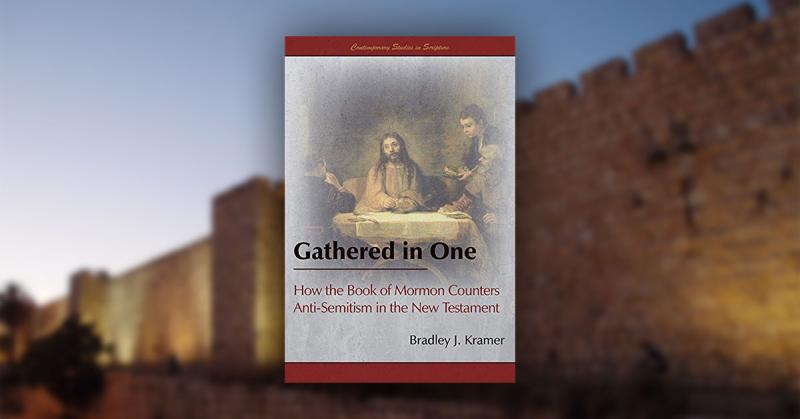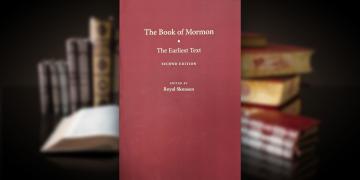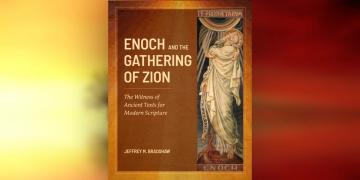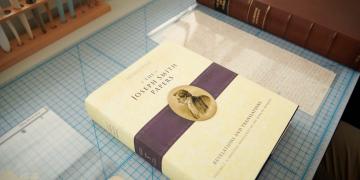You are here
Review: New Book Explores How the Book of Mormon Counters Anti-Semitism
It is a sad reality that anti-Semitism, or hostility, prejudice, suspicion, and violence towards Jews, still rears its ugly head in modern society. As with other forms of racial, religious, and class prejudice, anti-Semitism needs to be confronted and combated by members of The Church of Jesus Christ of Latter-day Saints. “Anti-Semitism has no place in our society,” read an official announcement by Church leaders after a horrendous mass-shooting at the Tree of Life Synagogue in Pittsburgh, Pennsylvania. “It is the responsibility of good people everywhere to speak out and stand up for each other’s rights to worship and live peacefully.” A new book by Latter-day Saint author Bradley J. Kramer explores how the signature book of Latter-day Saint scripture confronts historic Christian anti-Semitism. Gathered in One: How the Book of Mormon Counters Anti-Semitism in the New Testament is sure to be a challenging read for some members of the Church, but still provides a model for how to faithfully engage critical, controversial subjects.
As Kramer argues in his book, while the New Testament will forever remain cherished, foundational scripture for Christians all over the world, a frank reading of the text reveals harsh anti-Jewish language and themes that have historically strained Jewish-Christian interfaith relations. “There are problems with the way the New Testament presents Jews and Judaism, which even traditional Christians find disturbing,” Kramer writes:
To be clear, I do not blame Jesus or his apostles for this situation. Undoubtedly, they had issues with some Jews, contemporaries of theirs, people living and working around them. However, I do not believe they hated all Jews everywhere, nor do I think that they considered Jews inherently evil or corrupt. After all, Jesus and his apostles were Jews themselves—as were their closest neighbors, followers, family members, and friends. Neither do I condemn the original writers of the New Testament. As I see them, they were simply attempting to spread the “good news” of Jesus as best they could during a time when “Christianity” (the term had not yet been coined) was still working out its relationship with what would become mainstream Judaism. These writers did not know how their works would eventually be arranged, nor did they foresee what effect their words would have cumulatively on their readers. Nonetheless, there can be no doubt that many readers of the New Testament, past and present, have found within its pages support for anti-Semitic agendas. (pp. ix–x)
Kramer devotes one chapter (pp. 7–38) to overviewing the New Testament portrayals of Jews and Judaism which have been interpreted by even committed Christian scholars as containing anti-Semitic sentiments (or which have been used to justify anti-Semitic attitudes and teachings). “For instance, Matthew’s infamous blood curse—‘His blood be on us, and on our children’ (Matt. 27:25)—has been described by at least one Jewish scholar as ‘the most glaring of New Testament anti-Semitic passages,’ and several Christian scholars are inclined to agree” (p. 8). This passage and others like it must be carefully approached and contextualized by readers of the New Testament. Kramer reviews some of the “promising” and “possible” solutions (pp. 10, 15, 18, 23, 26, 35–38) offered by Christians in making sense of these problematic passages. These solutions range from proffered re-readings the New Testament with more sensitive historical-critical paradigms to retranslating select New Testament passages to soften anti-Semitic language. He concludes, however, that most of the solutions offered by leading Christian thinkers are not “completely satisfying to all readers, and each gives rise to additional questions and problems” (p. 38).
This is where Kramer brings the Book of Mormon into the conversation. How the Book of Mormon might be read to contextualize the apparent anti-Semitism encountered in the New Testament is the focus of the subsequent chapters of Kramer’s volume (pp. 39–141). As Kramer writes,
The Book of Mormon . . . counters the anti-Semitism present in the New Testament with statements condemning Christian persecution of the Jews as well as doctrines that promote such behavior. However . . . the Book of Mormon does not do so simply as an official church declaration or as a matter of ecclesiastical policy but as scripture—Christian scripture—that reinforces its pro-Judaic statements literarily, employing many of the same mechanisms as the New Testament but for the opposite effect. In this way, the Book of Mormon confronts the New Testament on its own turf and on its own terms and does so respectfully, even reverentially, modifying how the New Testament is understood without altering its words or undermining its authority. (p. 39)
For instance, Kramer cites and discusses important texts in the Book of Mormon that refute Gentile persecution of the Jews:
But thus saith the Lord God: O fools, they shall have a Bible; and it shall proceed forth from the Jews, mine ancient covenant people. And what thank they the Jews for the Bible which they receive from them? Yea, what do the Gentiles mean? Do they remember the travails, and the labors, and the pains of the Jews, and their diligence unto me, in bringing forth salvation unto the Gentiles? O ye Gentiles, have ye remembered the Jews, mine ancient covenant people? Nay; but ye have cursed them, and have hated them, and have not sought to recover them. But behold, I will return all these things upon your own heads; for I the Lord have not forgotten my people. (2 Nephi 29:4–5
Yea, and ye need not any longer hiss, nor spurn, nor make game of the Jews, nor any of the remnant of the house of Israel; for behold, the Lord remembereth his covenant unto them, and he will do unto them according to that which he hath sworn” (3 Nephi 29:8).
Passages such as these in the Book of Mormon have prompted not only Kramer but other writers as well to reflect on what the Book of Mormon teaches about the rightful place of ancient and modern Jews as part of God’s covenant people. “[T]he Book of Mormon does not change the New Testament’s words or call into question what might be called their ‘scripturality’—that is, their ability to convey divine messages to their readers directly, without an intermediary—but, for believers, it alters how the New Testament’s words are understood,” Kramer argues. “[A] continual stream of similar elements in the Book of Mormon unite to sweep away [anti-Semitic sentiments]. . . . Simply by adding these portrayals to the Christian canon and by placing them in larger contexts, the Book of Mormon effectively affirms the overall goodness of Jews, [and] confirms their ongoing place in God’s covenant” (pp. 40–41)
Kramer also draws attention to the Book of Mormon’s overall positive portrayal of Mosaic laws, ordinances, and festivals (pp. 67–111). For example, he highlights how Latter-day Saint scholars have convincingly seen sometimes faint, sometime overt depictions of Mosaic festivals (or elements thereof) in the Book of Mormon. “No longer are the Mosaic commandments nonsensical rules promoted by self-serving hypocrites [as portrayed in the New Testament],” observes Kramer.
They have practical value and are observed by sincere, admirable people. The Mosaic festivals too are not simply empty names, without ancient or contemporary significance. By presenting them as rituals, consistent with ancient practice but with hints of modern additions to that practice, the Book of Mormon confirms their ongoing utility both for itself as well as for the entire Christian canon. And, again, it does so without changing the text of the New Testament or otherwise undermining its scriptural authority or reliability. Since Rosh Hashanah, Sukkot, and Passover are presented so vibrantly in the Book of Mormon, the fact that the New Testament does not follow suit simply suggests that its description of these festivals is incomplete—that is was abbreviated for some reason, perhaps only because time or papyrus was limited. The New Testament is therefore not wrong, per sé. There is just more to these festivals than it describes, and consequently any argument requiring their replacement based solely on the New Testament is severely undermined. (p. 90)
To be sure, not all readers will likely agree with the severity or magnitude of the problem of anti-Semitism in the New Testament as identified and discussed by Kramer. Nor will all readers necessarily agree with his proposed solutions. Some might even question whether the New Testament is at all anti-Semitic. Nevertheless, the points Kramer raises are worth careful consideration. As with his previous book, Beholding the Tree of Life: A Rabbinic Approach to the Book of Mormon, Kramer demonstrates his devotion to the Book of Mormon in the pages of Gathered in One by offering a careful and respectful reading of the Nephite record in conjunction with other sacred texts. Whether one agrees with all of his arguments or conclusions, it is clear that Kramer sincerely wants to give the Book of Mormon a more prominent (and deserving) seat at the ecumenical table. The Book of Mormon has an important message for both Jews and Gentiles which should be carefully considered and pondered, and with Kramer’s help, that message becomes a little more intelligible and applicable in our world today.
Thoughtful, respectful interfaith dialogue between Christians—including Latter-day Saint Christians—and Jews is important, especially since many Jews still find themselves as a vulnerable religious minority in today’s society. It is also important to take seriously Jewish voices which have expressed sincere pain and frustration over how the New Testament has historically been exploited by Christians to promote anti-Semitic ideologies and find ways to heal the scars of the past. As Kramer convincingly shows, the Book of Mormon is a powerful tool in the fight against anti-Semitic prejudice and is just as relevant today as it has ever been.
Subscribe
Get the latest updates on Book of Mormon topics and research for free








